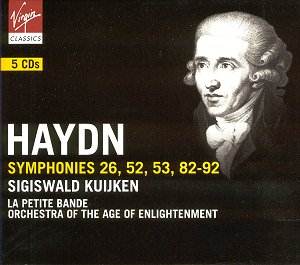Look at the catalogue of Haydn's compositions under
the headings of the forms in which he composed most frequently, such
as the symphony and string quartet, and the temptation is to think that
a formula is involved. Not so, of course, since beneath the sometimes
bland titles featuring numbers and keys there lurks the most wonderful
music.
It is a tribute to Sigiswald Kuijken and his two orchestras
that Haydn's range and personality come across so strongly in this attractive
5CD set. Take the first disc, for example. The orchestra is the smaller
of the two ensembles, La Petite Bande, the music the earliest among
the collection. There are two emotionally charged Sturm und Drang (Storm
and Stress) symphonies, Nos. 26 and 52, and one - No. 53 - which has
an atmosphere of celebration.
These characteristics are the starting point for Kuijken's
interpretations, and he is supported by the dedicated playing of his
players (as he is too when the other orchestra (the Orchestra of the
Age of Enlightenment) is involved). The music of these three symphonies
from the 1770s is strongly projected and carefully prepared, with tempi
and phrasing which consistently allow for details to be heard while
the line of musical continuity is maintained. If there is a caveat,
applying to these three symphonies rather than the later ones, it is
that the quality of the string sound may not appeal to all tastes. The
string body is relatively small (why can't we be told how many players
there are?) and the sound is neither comfortable nor particularly pleasing.
There is nothing unintentional about this, it is merely a reflection
of the sound of these musicians' gut strings.
In the later Symphonies played by this ensemble (Nos.
88-92) the string body seems more substantial, or at least the recorded
perspective is more sensitive to string sound, and the issue recedes
in importance. Indeed, these are highly successful interpretations of
works which are frequently neglected, coming as they do in between the
celebrated sets written for Paris and London. Kuijken's performances
are ever alert, keenly shaped and phrased, with no lack of excitement.
Symphony No. 91, hardly the best known among Haydn's works, emerges
as a real masterpiece, with a substantial first movement involving a
highly effective relationship between Largo introduction and sonata
form Allegro. The set is worth acquiring for the performance of this
symphony alone!
However, there are also two discs dedicated to the
great Paris Symphonies that Haydn composed for Count D'Ogny in the mid-1780s.
These were designed for a large and talented ensemble, and the atmospheric,
clear and balanced sound achieved by the recording engineers allows
for plenty of impact whenever it is required.
Kuijken directs spirited performances of the Paris
Symphonies. The opening movement of Symphony No. 83 (The Hen) is particularly
successful. The music is crisply articulated at the same time as being
sensitively phrased. The orchestral playing is really first class, with
a pleasing string tone which still achieves bite when the rhythms demand
it. Could there be a better example of what Haydn meant by 'Allegro
spiritoso'?
If the performance of this symphony has special qualities,
the other Paris symphonies are not far behind either. Each of them communicates
its own special personality. For instance, in Kuijken's hands the somewhat
neglected Symphony No. 84 in E flat has a thoughtful, almost introspective
air in the outer movements, whereas the minuet is lively and strongly
accented.
Keyboard continuos in the Paris performances are present
but very discrete and unobtrusive; perhaps this is something of a surprise,
though it is not a problem. The string band numbers some 25 players,
and generates sufficient body of sound to provide a suitable warmth
of expression whenever Haydn calls for it. Likewise woodwinds, brass
and timpani acquit themselves with distinction, helped by the clarity
of the recorded sound.
Caveats are few indeed. One is the tempo chosen for
the Allegretto movement of Symphony No. 85 (La Reine), which is surely
too slow and would be more safely described as an Andante, which Haydn
presumably did not want.
At its attractive price this collection has a clear
appeal. Above all it is a valuable addition to the Haydn discography
because the performances consistently do justice to the master's inventiveness
and succeed in confirming his greatness.
Terry Barfoot

